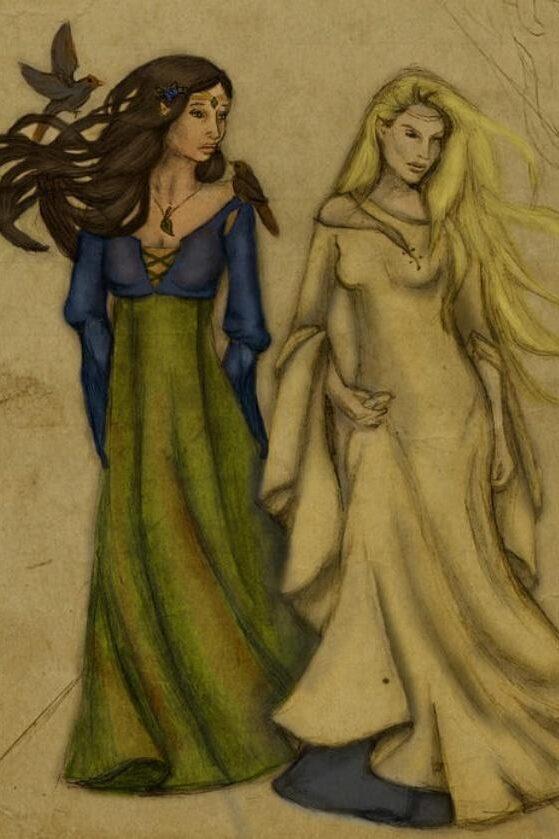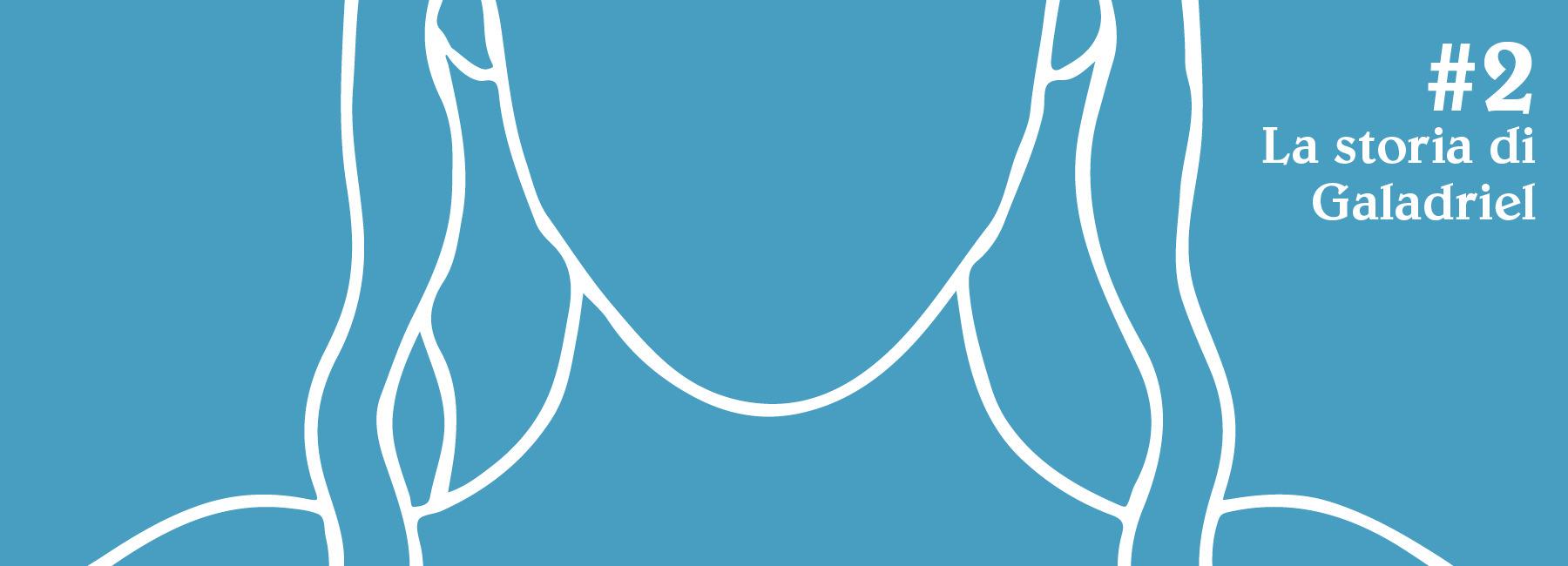di Benedetto Ardini
L’inserimento di Galadriel nel legendarium del Silmarillion (1950-1954)
TESTI TRATTATI IN QUESTA SEZIONE
(* anno indicativo A.A. Anno degli Alberi ? elemento non chiaro – elemento non presente nel testo)

CONCETTO CHIAVE: Galadriel viene inserita nel legendarium del Silmarillion a lei preesistente
Terminato lo sforzo di scrittura dei capitoli di The Lord of the Rings, all’inizio degli anni ‘50 Tolkien ritornò a lavorare sul corpus di leggende che aveva sviluppato a partire dalla sua giovinezza. Vi erano due grandi “tradizioni” del legendarium che aveva delineato fino a quel momento30:
- la forma annalistica degli Annals of Aman (riferiti ai Tempi Remoti fino alla fine dei Due Alberi e l’Esilio dei Noldor dal Reame Beato) e dei Grey Annals (riferiti alla Guerra dei Gioielli tra gli Elfi e Morgoth)
- la forma prosastica del Quenta (a questo stadio chiamato da Christopher Tolkien Later Quenta Silmarillion per distinguerlo dalla sua prima forma scritta negli anni ‘30)
Come mostra Christopher Tolkien, Galadriel a questo punto viene inserita in queste tradizioni facendo il suo ingresso nel legendarium del Silmarillion31. Negli Annals of Aman Galadriel è la figlia di Finrod (che successivamente verrà cambiato con Finarfin32) nata ad Eldamar nel Reame Beato e, da parte della madre Ëarwen, è imparentata con Re Thingol Grigiomanto33: tutte informazioni che verranno preservate nei testi successivi. In una nota, Tolkien scrisse che nacque nel 1362° Anno degli Alberi34: questa rimase l’unica data scritta riguardante la nascita di Galadriel anche se, come vedremo, sarà possibile ricavarne un’altra sulla base di alcuni conti che Tolkien farà in un periodo successivo. Considerando i Grey Annals e il Later Quenta Silmarillion la storia di Galadriel della Prima Era raggiunge praticamente il livello del Silmarillion “definitivo” che Christopher comporrà e pubblicherà nel 1977. Infatti troviamo i seguenti aspetti/fatti già delineati che verranno riproposti dal figlio di J.R.R. Tolkien:
- il cuore di Galadriel è acceso dalle parole di Fëanor (seppure non presti alcun giuramento per la riconquista dei Silmarilli rubati da Morgoth) quando i Noldor decidono di andare in Esilio da Aman35
- Galadriel è una delle guide della schiera di Fingolfin nell’attraversamento del Ghiaccio Stridente36 per guingere nel Beleriand
- durante la permanenza nel Beleriand ad un certo punto Galadriel e suo fratello Finrod sono ospiti di Thingol nel Doriath37 e Galadriel rimane a dimorare in quel regno (mentre Finrod va a fondare il regno di Nargothrond)
- nel Doriath Galadriel dialoga con Melian, la Maia, sui Silmarilli e la Fuga dei Noldor (anche Galadriel non vuole menzionare il Fratricidio di Alqualondë, la battaglia degli elfi Noldor contro gli elfi Teleri per conquistare le loro navi)38
- Galadriel va successivamente a far visita al fratello nel Nargothrond39
A questo stadio l’unico elemento ancora assente, rispetto al Silmarillion pubblicato, è proprio il rapporto di Galadriel con Celeborn nella Prima Era. Negli Annals e nel Quenta, a differenza del Silmarillion, la permanenza di Galadriel nel Doriath è giustificata dal fatto che Galadriel amava stare con Melian40 e non perché si era innamorata di Celeborn: questo è senz’altro in accordo con l’abbozzo del testo di Of the Rings of Power and the Third Age, che abbiamo visto in precedenza, in cui si può dedurre che Galadriel incontra Celeborn solo in un secondo momento a Lórien.

A questo stadio Of the Rings of Power and the Third Age rappresenta anche l’unico testo che dà informazioni relative a Galadriel nel passaggio tra Prima e Seconda Era: nè i Grey Annals nè il Later Quenta Silmarillion ci dicono nulla sulla fine dei Tempi Remoti infatti questi vennero abbandonati da Tolkien prima di arrivare a tal punto della narrativa41. Nemmeno il Tale of Years, l’unico testo scritto da Tolkien dopo The Lord of the Rings che tratti la Prima Era fino alla fine42, fa riferimento a Galadriel nel momento della caduta di Morgoth e la fine del Beleriand.
Nel periodo in cui stava inserendo Galadriel nel legendarium del Silmarillion Tolkien scrisse due lettere in cui faceva riferimento all’Elfa: una del 1951 in cui definisce la Galadriel di The Lord of the Rings ancora come una ‘Regina Elfica’43, attributo che negherà successivamente, e un’altra, del 1954, che ci conferma la sua nascita nel Reame Beato44 (in accordo con gli Annals e il Quenta).
30 Vedi The History of Middle-earth, vol.10, Morgoth’s Ring, Foreword, pag.vii, Ebook Edition © August 2021 ISBN: 9780008363697
31 “[…] Galadriel enters from The Lord of the Rings […]” (The History of Middle-earth, vol.10, Morgoth’s Ring, Part Two, The Annals of Aman, Commentary on the fourth section of the Annals of Aman, §85, pag.104, Ebook Edition © August 2021 ISBN: 9780008363697)
32 “[…] Galadriel enters the Quenta tradition […]” (The History of Middle-earth, vol.10, Morgoth’s Ring, Part Three, The Later Quenta Silmarillion, Commentary on Chapter 5, ‘Of Eldanor and the Princes of the Eldalië’, §42, pag.182, Ebook Edition © August 2021 ISBN: 9780008363697) “‘The Lady Galadriel of the royal house of Finrod, father of Felagund, Lord of Nargothrond’ (a statement that was changed in the Second Edition of The Lord of the Rings, when Finrod had become Finarphin and Inglor had become Finrod (Felagund)).” (The History of Middle-earth, vol.10, Morgoth’s Ring, Part Two, The Annals of Aman, Commentary on the fourth section of the Annals of Aman, §85, pag.104, Ebook Edition © August 2021 ISBN: 9780008363697)
33 Nell’Anno degli Alberi 1280 si trova: “In this year Finrod Finwë’s son wedded Ëarwen King Olwë’s daughter of Alqualondë, and there was a great feast in the land of the Teleri. Thus the children of Finrod, Inglor and Galadriel, were the kin of King Thingol Greymantle in Beleriand.” (The History of Middle-earth, vol.10, Morgoth’s Ring, Part Three, The Annals of Aman, §85, pag.93, Ebook Edition © August 2021 ISBN: 9780008363697) 34 “After the annal for 1350 two entries were added: 1362 Galadriel, daughter of Finrod, born in Eldamar.” (The History of Middle-earth, vol.10, Morgoth’s Ring, Part Three, The Annals of Aman, Commentary on the fourth section of the Annals of Aman, §86, pag.106, Ebook Edition © August 2021 ISBN: 9780008363697)
35 Si veda il passaggio “[…] Galadriel, the only woman of the Noldor to stand that day tall and valiant among the contending princes, was eager to be gone. No oaths she swore, but the words of Fëanor concerning Middle-earth had kindled her heart, and she yearned to see the wide untrodden lands and to rule there a realm maybe at her own will. For youngest of the House of Finwë she came into the world west of the Sea, and knew yet nought of the unguarded lands.” negli Annals of Aman (The History of Middle-earth, vol.10, Morgoth’s Ring, Part Two, The Annals of Aman, Of the Speech of Fëanor upon Túna, §135, pag.112, Ebook Edition © August 2021 ISBN: 9780008363697) e nel Silmarillion (The Silmarillion, Quenta Silmarillion, ch.9 Of The Flight of the Noldor, pag.89, Ebook Edition © FEBRUARY 2011 ISBN: 9780007322565)
36 “[…] led by Fingolfin and his sons, and by Inglor and Galadriel the valiant and fair, they dared to pass into the untrodden North, and finding no other way they endured at last the terror of the Helkaraxë and the cruel hills of ice.” si veda in Annals of Aman (The History of Middle-earth, vol.10, Morgoth’s Ring, Part Two, The Annals of Aman, Fifth Section of the Annals of Aman, §163, pag.120, Ebook Edition © August 2021 ISBN: 9780008363697) e nel Silmarillion (The Silmarillion, Quenta Silmarillion, ch.9 Of The Flight of the Noldor, pag.97, Ebook Edition © FEBRUARY 2011 ISBN: 9780007322565)
37 “52 In this year Inglor and his sister Galaðriel were long the guests of Thingol their kinsman. And Inglor was filled with wonder at the beauty and strength of Menegroth […]” (The History of Middle-earth, vol.11, The War of Jewels, Part One, The Grey Annals, §75, pag.35, Ebook Edition © DECEMBER 2021 ISBN: 9780007348282) “And it came to pass that Inglor and Galadriel were on a time the guests of Thingol and Melian; for there was friendship between the lord of Doriath and the House of Finrod that were his kin, and the princes of that house alone were suffered to pass the girdle of Melian. Then Inglor was filled with wonder at the strength and majesty of Menegroth […]” (The History of Middle-earth, vol.11, The War of Jewels, Part Two, The Later Quenta Silmarillion, 10 Of the Siege of Angband, §101, pag.178, Ebook Edition © DECEMBER 2021 ISBN: 9780007348282). Si confrontino questi passaggi con quello nel Silmarillion (The Silmarillion, Quenta Silmarillion, ch.13 Of The Return of the Noldor, pag.129, Ebook Edition © FEBRUARY 2011 ISBN: 9780007322565)
38 “And at times they would speak together of Valinor and the bliss of old; but beyond the dark hour of the death of the Trees Galaðriel would not go, but fell ever silent. […] Melian looked in her eyes, […] Then Galaðriel spoke to Melian of the Silmarils, and of the slaying of King Finwë. But still she said no word of the Oath, nor of the Kinslaying, nor of the burning of the ships.” (The History of Middle-earth, vol.11, The War of Jewels, Part One, The Grey Annals, §91-94, pag.40, Ebook Edition © DECEMBER 2021 ISBN: 9780007348282) si confronti con il testo nel Silmarillion (The Silmarillion, Quenta Silmarillion, ch.15 Of the Noldor in Beleriand, pag.148, Ebook Edition © FEBRUARY 2011 ISBN: 9780007322565)
39 “About this time it is recorded that Nargothrond was full-wrought, and Finrod’s sons were gathered there to a feast and Galadriel came from Doriath and dwelt there a while. Now King Inglor Felagund had no wife, and Galadriel asked him why this was; but foresight came upon Felagund as she spoke, and he said: ‘An oath I too shall swear, and must be free to fulfill it and go into darkness.” (The History of Middle-earth, vol.11, The War of Jewels, Part One, The Grey Annals, §108, pag.44, Ebook Edition © DECEMBER 2021 ISBN: 9780007348282) si confronti con il testo nel Silmarillion (The Silmarillion, Quenta Silmarillion, ch.15 Of the Noldor in Beleriand, pag.150, Ebook Edition © FEBRUARY 2011 ISBN: 9780007322565)
40 Si confrontino i testi “But Galaðriel did not depart [added later: from Doriath], and remained long with Melian, for there was much love between them.” (The History of Middle-earth, vol.11, The War of Jewels, Part One, The Grey Annals, §75, pag.35, Ebook Edition © DECEMBER 2021 ISBN: 9780007348282) e “Yet Galadriel his sister dwelt never in Nargothrond, but remained in Doriath and received the love of Melian, and abode with her, and there learned great lore and wisdom concerning Middle-earth.” (The History of Middle-earth, vol.11, The War of Jewels, Part Two, The Later Quenta Silmarillion, 10 Of the Siege of Angband, §101, pag.178, Ebook Edition © DECEMBER 2021 ISBN: 9780007348282) con il corrispettivo testo nel Silmarillion “Galadriel his sister went not with him to Nargothrond, for in Doriath dwelt Celeborn, kinsman of Thingol, and there was great love between them. Therefore she remained in the Hidden Kingdom, and abode with Melian, and of her learned great lore and wisdom concerning Middle-earth.” (The Silmarillion, Quenta Silmarillion, ch.13 Of the Return of the Noldor, pag.130, Ebook Edition © FEBRUARY 2011 ISBN: 9780007322565)
41 Tolkien abbandonò i Grey Annals alla morte di Túrin Turambar. Scrive Christopher: “It always seemed to me strange that my father should have abandoned the Grey Annals where he did, without at least writing the inscription that was carved on the stone; yet the facts that the amanuensis typescript ended at this point also, and that he added in the inscription in rough script on the manuscript at some later time, seemed proof positive that this was the case.” (The History of Middle-earth, vol.11, The War of Jewels, Part One, The Grey Annals, §349, pag.103, Ebook Edition © DECEMBER 2021 ISBN: 9780007348282) Per quanto concerne il Late Quenta Silmarillion: “The completion of the Quenta Silmarillion remained an aim; but the ‘great tales’, vastly developed from their original forms, from which its later chapters should be derived were never achieved.” (The History of Middle-earth, vol.11, The War of Jewels, Part Two, The Later Quenta Silmarillion, The Last Chapters of the Quenta Silmarillion, pag.244, Ebook Edition © DECEMBER 2021 ISBN: 9780007348282)
42 Christopher Tolkien sottolinea la mancanza della fine dei Tempi Remoti nel testo dei Grey Annals e l’inadeguatezza del materiale nel Tale of Years come fonti post-The Lord of the Rings nello sviluppo della mitologia tolkieniana: “But from the point where the Grey Annals were abandoned The Tale of Years becomes a major source for the end of the Elder Days, and indeed in almost all respects the only source deriving from the time following the completion of The Lord of the Rings, woefully inadequate as it is.” (The History of Middle-earth, vol.11, The War of Jewels, Part Three, The Wanderings of Húrin and Other Writings not forming part of the Quenta Silmarillion, pag.344, Ebook Edition © DECEMBER 2021 ISBN: 9780007348282)
43 Si tratta della lettera a Milton Waldman: “I have not used ‘magic’ consistently, and indeed the Elven-queen Galadriel is obliged to remonstrate with the Hobbits on their confused use of the word both for the devices and operations of the Enemy, and for those of the Elves.” (Humphrey Carpenter, The Letters of J.R.R. Tolkien, letter n°131)
44 Si tratta della lettera a Naomi Mitchinson: “Galadriel is as old, or older than Shelob. She is the last remaining of the Great among the High Elves, and ‘awoke’ in Eldamar beyond the Sea, long before Ungoliante came to Middle-earth and produced her broods there.” (Humphrey Carpenter, The Letters of J.R.R. Tolkien, letter n°144)
Laureato in Ingegneria Fisica al Politecnico di Milano dove sta proseguendo la sua carriera come PhD. Fin da bambino è appassionato di Tolkien i cui libri rappresentano per lui uno stimolo e un accompagnamento fondamentali per la vita di tutti i giorni.



